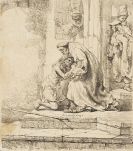
Polidoro da Caravaggio
1500 Caravaggio
1543 Messina
The Italian painter, draughtsman and architect Polidoro da Caravaggio was actually christened Polidoro Caldara. Caravaggio’s precise date of birth is unknown. He is thought to have been born between 1490 and 1500. According to Vasari’s "Le Vite de' piú eccellenti pittori scultori ed architettori da Cimabue insino a' tempi nostri", Caravaggio worked as a hod carrier on the construction of Raphael’s loggia in Rome. The artist is thought to have been 18 years old when the painting work began (1517-19). According to Vasari, it was during this work that Caravaggio decided to become an artist. The fresco frieze on the first floor of the Palazzo Baldassarini, completed between 1517-18, is thought to include his earliest work. A census from that time shows that Polidoro da Caravaggio was registered as a painter in Rome. Whether he was actually involved in painting the logge is debated. He may have only painted "The Passage through Jordan" and the "Storming of Jericho" in the tenth bay, as well as some of the gargoyles on these arches.
It is thought that he had close contact with Raphael’s workshop, although it is unlikely that he was the artist’s apprentice.
Polidoro da Caravaggio met the Florentine painter Maturino and worked with him. They devoted themselves to monochrome wall painting, so-called scraffito painting. Caravaggio is known to have painted more than 40 house facades, but these have been damaged by exposure, and are now all almost completely destroyed. The various artists’ engravings are the only parts remaining, which allow for a reconstruction. Even artists such as Parmigianino and Rubens copied the originals. Most of the images are based on Roman history and mythology.
The artist is also thought to have stayed in Naples during this period (1523-24), where he painted scenes from antiquity on four walls of the courtyard and the loggia of L. Montalto’s Palazzo. In 1527, Polidoro da Caravaggio fled Rome for Naples, in order to escape the sack of Rome. Vasari claims that the artist was unemployed in Naples because "These rulers had little interest in real art". However, it is more likely that Polidoro Caravaggio continued to work there as a facade painter. At the end of the 1520s, he travelled from Naples to Messina. The only pictures to have survived this period are panels. Of particular note is "Christ carrying the cross" (1534), a work much vaunted by Vasari, which is now in Naples. In 1543, the night before he was due to return to Rome, Polidoro Caravaggio was allegedly robbed and murdered by his assistant Tonno Calabrese.

Would you like to sell a work by Polidoro da Caravaggio?
Infos for sellerART MARKET:

Rückkehr des verlorenen Sohnes
1636
Post-Auction Sale 3.000
More offers >






